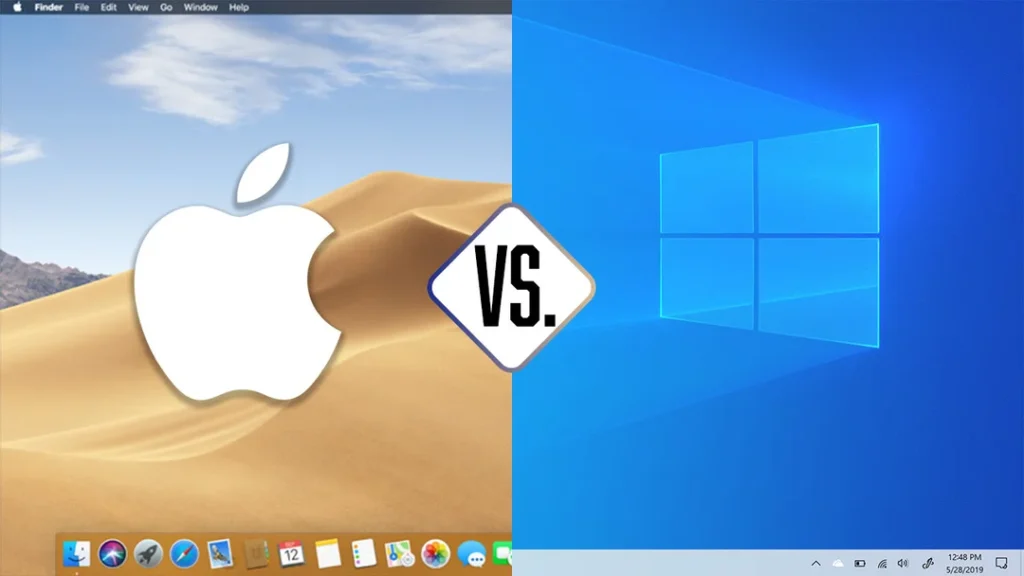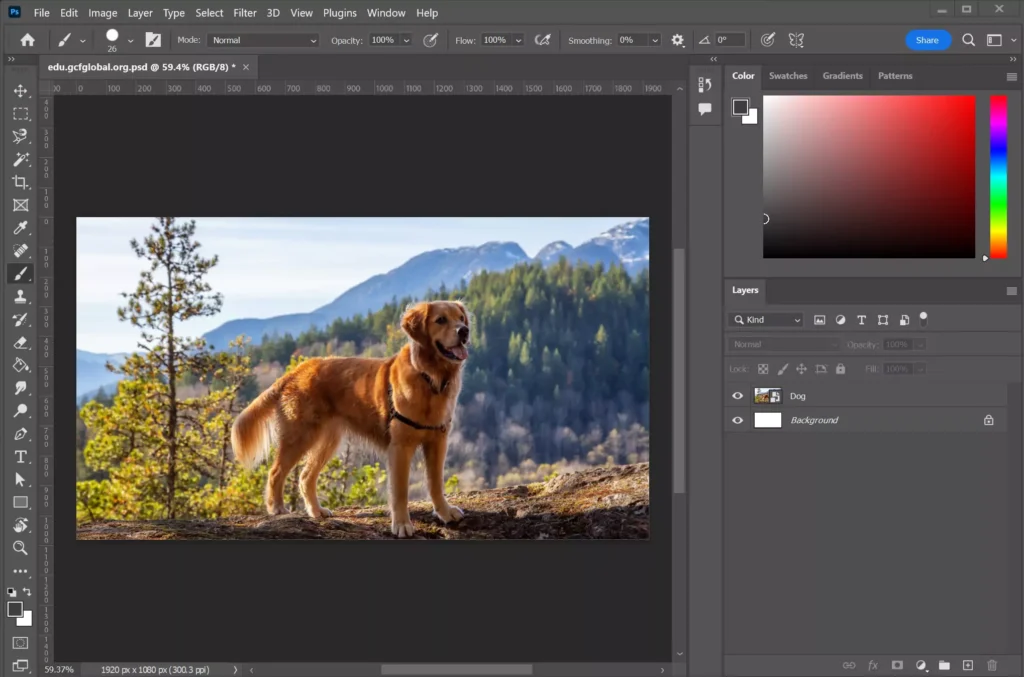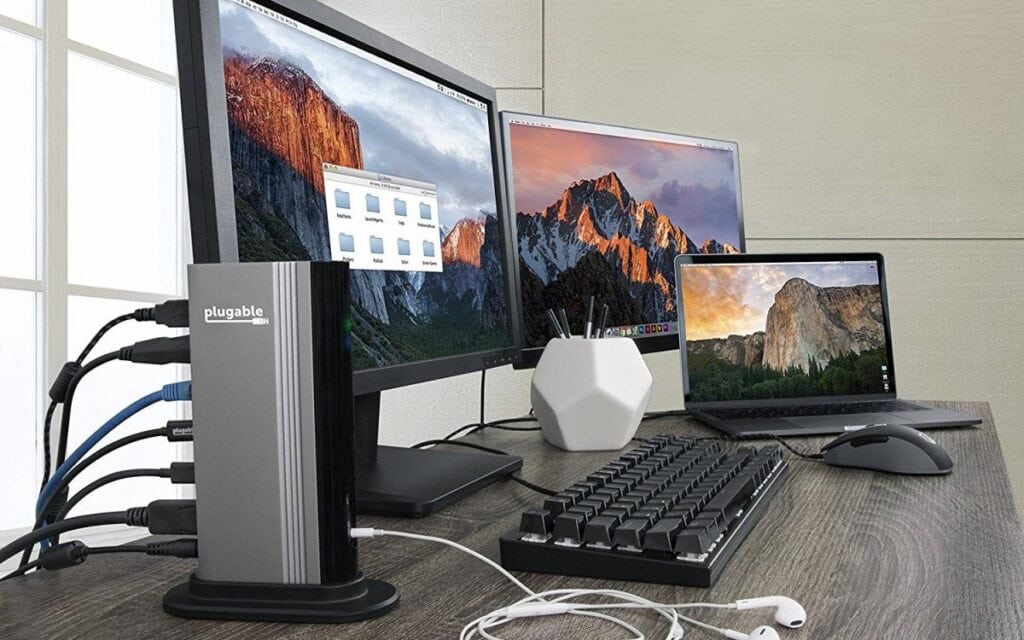Mac vs PC: Which is Best for Graphic Designers?
Graphic designers have a tough choice when selecting a computer platform. The classic debate between Apple Mac and Windows PC has raged in the creative community for decades. With the advancement of technology, the lines have blurred between the capabilities of Mac vs PC hardware. However, there are still some critical differences graphic designers must consider when deciding whether to go Mac or PC. This article will break down the key factors to help you determine the best option for your graphic design needs.
Table of Contents
Mac vs PC: Hardware Capabilities

The hardware capabilities are essential in providing the horsepower graphic designers need for CPU and GPU-intensive creative applications.
CPU Performance
Regarding processing power, high-end Windows PCs and Macs now use similar Intel processors and tend to benchmark closely for single-core performance. However, Macs edge out most consumer Windows machines for multi-threaded tasks that leverage the whole processor.
The M1 and M2 Apple silicon chips available in newer Mac models also outpace many Windows rivals for CPU-intensive tasks thanks to their efficiency and unified system memory architecture. However, PC workstations with the latest AMD or Intel processors remain the top choices for raw processing power.
GPU Performance
The graphics card plays a significant role in accelerating rendering and effects in design programs. Macs include fairly decent GPUs, even at more affordable price points. However, most PC configurations allow you to choose higher-end GPU options ideal for 3D, video editing, and animation work.
Nvidia RTX cards provide excellent performance if your applications can leverage CUDA acceleration. AMD Radeon Pro cards are also compelling choices found in higher-end Mac hardware. Overall, GPU versatility and upgradability still favour PCs.
Memory and Storage
Memory and fast storage are vital for complex creative projects. Most modern Macs and PCs can be configured with ample RAM and SSD storage to meet a graphic designer's needs. Macs have moved to efficient unified memory architectures that allow CPU and GPU to share memory access. Top-end Windows PCs can still be outfitted with more total memory capacity, tremendously aiding multimedia projects.
Display Quality
Graphic design requires accurate colour representation and sharp detail. Macs stand out here with their stellar high-resolution Retina displays featuring consistent colour calibration out of the box. Some Windows laptop displays have closed the gap in recent years. However, a colour-calibrated, high-gamut external display remains essential for critical colour work on any platform.
Customisation and Upgrades
PCs provide almost unlimited options for customising hardware to your needs and budget. Entire PC systems can easily be pieced together from interchangeable commodity components. Future upgrades like adding more RAM, a bigger SSD, or a new graphics card are straightforward for PC power users.
Macs offer far less flexibility or user upgradability, though higher-end Mac Pro and Mac Studio models allow some internal expansion. Sticking to Apple's fixed hardware configurations limits future upgrade paths for Mac users.
Operating System Differences

Choosing Windows or macOS can have huge workflow implications based on how each platform handles fonts, assets, shortcuts, window management, and other critical creative tools.
Stability and Reliability
Nothing kills creative momentum faster than crashes, bugs, and system instability. Apple's walled garden's confined hardware and software environments generally provide reliable performance. Windows historically struggled with stability, but Microsoft has ironed out many kinks in recent OS versions.
Long uptimes for mission-critical tasks still tend to favour macOS. However, savvy Windows users running clean software configurations can achieve similar stability by limiting buggy app installs. As always, thorough backups are wise insurance on any OS.
Font Management
Fonts are the graphic designer's palette. Smooth font handling is imperative for flawless text rendering across apps. Macs excel here by storing fonts in standardised ways that minimise conflicts.
Windows offers less consistent font management, occasionally resulting in missing or mismatched glyphs. But Windows does support OpenType variable fonts with responsive glyph interpolation, a newer feature missing from macOS. Overall, most designers still find font workflows more seamless on Mac.
File Management
The Finder on macOS makes working with files intuitive via icon or column view. Creative file structures are easy to recognise with thumbnail previews. Windows Explorer has improved but feels less fluid when visually parsing files. Mac file operations tend to feel more elegant.
Search Capabilities
Finding assets quickly is critical for designers. Windows search functions have been hit or miss over the years. Mac Spotlight and Time Machine yield better results for mining down project files and digging up old versions. Useful macOS metadata review options are missing from Windows search tools.
Shortcuts and Customisation
Both platforms provide ways to customise shortcuts and UI behaviour to accelerate repetitive tasks. Mac users can create Automator workflows, while Windows offers PowerShell scripting. Each OS has its perks here. However, Windows generally allows configuring more extensively tailored workflows.
Creative Applications

The availability of essential graphic design software determines what platform creative pros can seriously consider. Let's compare options across critical categories.
Raster Graphics Editors
Photoshop reigns supreme for image manipulation and composition. Both Mac and Windows run Photoshop equally well. However, other capable raster editors like Affinity Photo and Pixelmator are MacOS exclusives. GIMP provides a free cross-platform Photoshop alternative. So, both platforms are well covered for pixel pushing.
Raster Graphics Software Comparison
| Software | Mac | Windows |
| Adobe Photoshop | ✅ | ✅ |
| Affinity Photo | ✅ | |
| Pixelmator | ✅ | |
| GIMP | ✅ | ✅ |
Vector Graphics Editors
Illustrator is Mac and Windows's de facto vector drawing/layout app. However, Affinity Designer has earned a spot as a capable lower-cost Illustrator substitute on Mac. CorelDRAW retains loyal followers on Windows. This category is reasonably even.
Vector Graphics Software Comparison
| Software | Mac | Windows |
| Adobe Illustrator | ✅ | ✅ |
| Affinity Designer | ✅ | |
| CorelDRAW | ✅ |
Page Layout Software
InDesign dominates print-based page layout, available for both platforms. Affinity Publisher is an emerging Mac-only option. QuarkXPress still holds a significant market share in print design circles and cross-platform. Despite Apple's early desktop publishing leadership, Windows choices now roughly rival macOS for publication work.
Page Layout Software Comparison
| Software | Mac | Windows |
| Adobe InDesign | ✅ | ✅ |
| Affinity Publisher | ✅ | |
| QuarkXPress | ✅ | ✅ |
3D and Animation Tools
Surprisingly, Mac lacks 3D and animation options compared to Windows. Heavy hitters like Autodesk Maya, 3ds Max, Blender, and Cinema 4D are essentially Windows – or Linux-based packages. After Effects and Premiere work on both platforms. However, those needing serious 3D power should generally lean toward PC.
Animation Software Comparison
| Software | Mac | Windows |
| Maxon Cinema 4D | ✅ | ✅ |
| Autodesk Maya | ✅ | |
| Autodesk 3ds Max | ✅ | |
| Blender | ✅ | ✅ |
| Adobe After Effects | ✅ | ✅ |
| Adobe Premiere Pro | ✅ | ✅ |
Mobile Device Ecosystems
Today's creative workflows extend across mobile devices. The iPhone camera feeds photo retouching apps on iPad while sketches are transferred straight into Mac vector layouts from iPad Pro illustration tools. Seamless handoff between devices supercharges productivity. This gives Apple's entirely in-house ecosystem an edge for designers invested heavily in their various devices.
Microsoft's Surface line has made Windows tablets more viable for portable digital art. And iOS/iPadOS interoperability with Windows has improved. However, Apple still dominates when leveraging mobile power for pro design.
Pricing Considerations

Hardware costs are tricky to compare since highly customisable Windows PCs span a vast spectrum based on configuration and component choices. However, looking at Apple's fixed configurations yields some insights.
On the PC side, building capable graphic design machines for under $1,000 is entirely possible by choosing budget components. High-end custom PC workstations can easily exceed $5,000 without breaking a sweat.
Most Mac models land somewhere between, typically carrying premium price tags but packed with premium components that customers cannot customise. The performance-per-dollar value favours budget PCs, while top-shelf Macs provide more consistency.
Let's analyse sample hardware configurations at a few common creative pro price points.
$1,500 Budget Creative Laptops
| Machine | OS | CPU | GPU | RAM | Storage | Display |
| Dell XPS 15 | Windows | 11th-gen Intel i7 | Nvidia RTX 3050 | 16GB DDR4 | 512GB SSD | 15″ 1080p Touch |
| MacBook Pro 14″ | macOS | M1 Pro 8-core | 16-core GPU | 16GB | 512GB SSD | 14″ Retina XDR |
- Dell packs in excellent specs but lacks MacBook's stunning mini-LED screen
- MacBook Pro wins on mobility, screen quality, battery life
- Dell saves money for those fine with 1080p display
$3,000 High-End Creative Laptops
| Machine | OS | CPU | GPU | RAM | Storage | Display |
| Razer Blade 15 | Windows | 12th-gen Intel i9 | Nvidia RTX 3080 Ti | 32GB DDR5 | 1TB SSD | 15″ 1440p 240Hz |
| MacBook Pro 16″ | macOS | M1 Max 12-core | 32-core GPU | 64GB | 1TB SSD | 16″ Retina XDR |
- Razer hits new performance heights but cuts corners on screen
- MacBook Pro power efficiency excels thanks to Apple's silicon
- Both are amazingly quick laptops for creative pros
$6,000 Premium Desktop Workstations
| Machine | OS | CPU | GPU | RAM | Storage | Displays |
| Custom PC Build | Windows | AMD Threadripper 3970X 32-core | 2x Nvidia RTX 3090 | 128GB DDR4 | 4TB SSD | Dual 32″ 4K |
| Mac Studio Max | macOS | M1 Ultra 20-core | 64-core GPU | 128GB | 4TB SSD | One 27″ 5K built-in |
- Custom PC delivers ludicrous multitasking muscle
- Mac Studio wins on elegant design and workflow simplicity
- It is mostly overkill for normal graphic design scenarios
While Windows PCs scale readily to extreme configurations like the one above, most designers find Mac hardware meets their daily needs at more down-to-earth prices. Simplicity costs extra—you are partly paying for the Apple logo mystique. However, within packages like MacBook Pro or iMac, Apple's components collaborate exceptionally well and are suitable out of the box, which aids real-world creative throughput.
Support, Security, and Longevity

Working with expensive professional equipment means depending on solid product support when issues arise. Reliability and security also ensure systems remain stable for the long haul.
Technical Support
Apple is renowned for its retail Genius Bars and customer support network. Even though Macs see fewer acute issues requiring troubleshooting, it's reassuring that Apple experts can provide helpful hands-on assistance when necessary. This perk helps justify premium Apple pricing.
DIY Windows users rely heavily on their technical savvy for upkeep and system maintenance. However, knowledgeable PC experts are never too far from local computer shops if you need hardware service. Overall, support advantages lean toward Apple.
Security
Protecting files and systems from intrusions is vital when handling client assets in creative workflows. Apple scores high here thanks to built-in encryption, malware scanning, secure boot capabilities, and regular security patches. Breaches are not impossible but remain relatively rare in practice.
Windows 10 and 11 have bolstered security lately with welcome features like application sandboxing and threat alerts. However, inherently open Windows environments are challenging to lock down fully from vulnerabilities. Vigilant Windows users can harden defences but should always practice smart cyber hygiene on PC.
Lifespan and Upgradeability
Today's Apple silicon Macs impress with both remarkable performance now and surprising longevity going forward. Efficient ARM-based architecture and unified system memory help M1 and M2 chips feel speedy even years later. Elements like soldered storage do limit repairability, however.
Commodity Windows PCs carry more uncertainty regarding future-proofing raw CPU speeds and specs as we hit the limits of Moore's Law. But refreshingly upgradable components like swappable GPUs, storage, and RAM help extend high-end PC lifespan considerably through easy upgrades. Expect five years from a premium PC if appropriately handled.
Style, Workflow, and Creative Inspiration

Technical factors dominate platform evaluations, but softer creative intangibles still sway decisions for designers, too.
The legendary aesthetic care Apple pours into devices like the iMac and MacBook Pro gives Apple computing an emotional spark Windows lacks. Clean Mac industrial design not only pleases the eye but disappears from the mind, so creativity shines brighter. Apple projects the right modern image for artists who view tools as expressive extensions of self.
A simplified macOS user experience facilitates distraction-free focus when crafting. Complex software capability melts away through macOS consistency, allowing unbroken concentration connecting pen, ink, and Bezier. Meanwhile, Windows fragments attention across various interfaces and technical minutiae. Smooth Mac navigation focuses on sculpting vector shapes rather than fussing with technicalities.
Reassuring reliability also frees mental worry from the hardware so ideas flow onto the page more effortlessly. Surprises throw off the rhythms of the muse. Few technology fountains run deeper and clearer for creators seeking stable inspiration wells than MacBook and iMac. Sure, many top artists and designers running Windows produce outstanding creative work through skill and force of will. However, when seeking a natural creative conduit, Apple continues to carry the aura and spirit that artists seek.
Conclusion
In the enduring Mac vs PC debate, graphic designers benefit from both platforms thanks to increasingly comparable hardware specifications and cross-platform creative app availability in recent years. For most artists and media producers, choosing macOS versus Windows comes down to nuanced workflow preferences and where they feel most comfortable wielding digital tools of the trade.
Macs traditionally held advantages in font management, operating system stability, display quality, and mobile ecosystem integration that appealed to graphics pros and creative types. Windows PCs delivered strengths in hardware customisation flexibility, upgradeability, and affordability, particularly for extreme performance configurations.
Apple Silicon Macs now rival PC CPUs thanks to excellent efficiency and good graphics capability. Top-end Windows CPUs and add-in cards still dominate benchmarks. Similarly, macOS hides technicality better, while Windows reveals deeper technical control.
Ideally, graphic designers can leverage dual environments by running both Mac and Windows machines synced through cloud assets and collaboration. Successfully straddling platforms smooths project demands requiring specific OS capabilities while allowing individuals to toggle their preferred workflow style day-to-day.
If forced to a single computer for design, most graphics professionals still narrowly favour purchasing a capable MacBook Pro or iMac as their daily creative driver. Tradition indeed plays some role in perpetuating Apple's hold on creative mindshare. However, Apple has also earned that authority through the reliable execution of hardware and human interfaces optimised around the sensitive aesthetics of art creation.
FAQs
Should I buy a gaming PC or Mac for graphic design?
While gaming PCs provide exceptional hardware capability on paper through high-end components, a Mac generally offers a smoother overall creative experience. Save extreme gaming PCs for 3D work.
Can a Mac run all Windows software needed for graphic design?
Macs provide full Windows compatibility through the virtualisation utility Parallels Desktop and other options. This allows most Windows graphic design apps to function correctly on Mac hardware while retaining macOS advantages.
Is an all-in-one iMac or Mac Studio better value than a PC desktop?
For graphic design scenarios that do not require constant hardware upgrades, iMac and Mac Studio deliver excellent capability and longevity in more straightforward all-in-one packages than traditional desktop towers. Expect to pay an Apple premium for design.
How long do Macs last compared to Windows PCs?
With proper maintenance, both platforms can quickly achieve 5+ years of usable lifespan. Macs age more gracefully thanks to Apple's balance of quality components and software optimisation. However, upgradable Windows PC components allow for the extension of viability even longer through upgrades.
Can iPad Pro fully replace graphic design laptop needs?
While Apple's iPad Pro packs impressive drawing/editing capabilities, most graphics professionals still need the fuller app ecosystem, storage capacity, multitasking flexibility, and peripheral support MacBook Pro provides for robust production design environments.
Last update on 2024-05-15 / Affiliate links / Images from Amazon Product Advertising API






You are mistaken about Affinity products not being PC compatible. I’ve been using Serif/Affinity suite for 20 years on my PC. Excellent programs for their extremely affordable price.